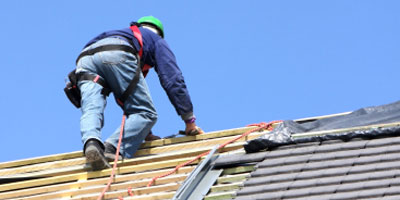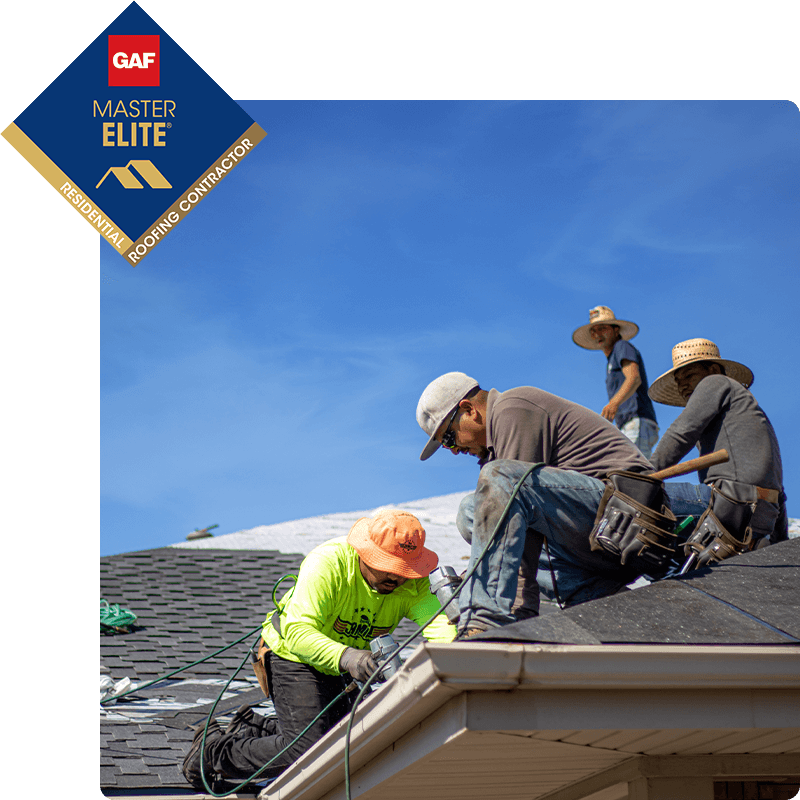What to Expect When Hiring a Siding Contractor for an Eco-Friendly Remodel
How Weather Can Impact Your Roof Long Life
Your roofing encounters consistent difficulties from the climate, and it's critical to recognize just how these conditions can shorten its life-span. Each element plays a duty in your roof's longevity, yet exactly how can you effectively prepare for these threats?
The Impacts of UV Rays on Roof Covering Products
Although you could not consider it frequently, UV rays can considerably affect the life expectancy of your roof materials. When your roofing system is subjected to sunshine, those harmful rays can create considerable damages with time. UV radiation breaks down the chemical bonds in materials like asphalt shingles, leading to breaking, fading, and degeneration. This degradation compromises your roofing system and makes it less efficient at safeguarding your home (Roofer Novi).
Normal evaluations also assist capture very early signs of damage, enabling you to resolve concerns prior to they intensify. By remaining aggressive about UV direct exposure, you'll expand the life of your roof covering and improve your home's overall resilience.
How Too Much Rainfall Can Lead to Roof Covering Damages
While UV rays can weaken your roofing, excessive rainfall postures another considerable hazard to its integrity. When heavy rainfalls occur, water can pool on your roof covering, resulting in possible leaks and structural damages in time. If your roofing products aren't created to deal with long term exposure to dampness, they can weaken faster than expected.
Clogged up gutters can worsen these issues, triggering water to overflow and seep into your home. You might notice discolorations on your ceilings or wall surfaces, indicating that water is locating its means inside. Furthermore, standing water can advertise mold growth, which not just harms your roofing however can also influence your indoor air high quality.
To safeguard your roofing system, verify your drain systems are clear and working effectively. Routine inspections can help you recognize weak places prior to they become costly repairs, maintaining your roof in great form even throughout hefty rainfall.
The Influence of Snow and Ice Accumulation
When snow and ice stack up on your roof, you might not recognize the tension it places on the structure. That included weight can result in severe issues like roofing system drooping or even collapse. Plus, ice dam development can catch water, causing leakages and more damage to your home.
Snow Load Anxiety
As wintertime blankets your home in snow, the weight of gathered ice and snow can put substantial tension on your roofing. You could not realize exactly how promptly snow can accumulate, particularly throughout hefty storms, so it's vital to maintain an eye on the weight your roof is supporting. In addition, recognizing your roofing system's framework and its snow lots score can educate you about when to take activity.
Ice Dam Formation
Ice dam development can end up being a significant problem during winter months, specifically when snow accumulates on your roofing system and temperature levels vary. When warmth runs away from your home, it melts the snow on your roofing system, causing water to move down. You ought to also routinely get rid of snow accumulation from your roofing system.
Temperature level Changes and Their Duty in Roofing Wear And Tear
Temperature changes can seriously impact your roof covering's life-span. As materials increase and contract with warmth and cold, they come to be much more at risk to fractures and damage. In addition, freeze-thaw cycles can worsen these problems, bring about additional wear and tear over time.
Thermal Development Results
When temperatures rise and fall, your roofing system can undergo substantial thermal expansion and contraction, which might lead to material stress and anxiety and degeneration over time. As the sun warms your roof covering during the day, materials broaden; when temperatures go down at night, they this link contract. Normal assessments can also assist you capture early indicators of wear, ensuring your roofing remains resilient and reliable in protecting your home.
Freeze-Thaw Cycles
As wintertime sets in, the freeze-thaw cycles can inflict chaos on your roof covering. As it freezes, it increases, putting enormous pressure on your roofing materials.
Overlooking these issues can lead to even more substantial troubles, consisting of leaks and architectural damage. To protect your roofing system, it's necessary to inspect it on a regular basis, specifically after extreme weather. Resolving minor concerns immediately can assist extend the life of your roof covering, guaranteeing it endures the extreme impacts of freeze-thaw cycles throughout winter season.
Humidity Levels and Their Effect on Roofing System Honesty
While lots of people concentrate on temperature level changes, humidity degrees play an essential duty in determining the stability of your roof covering. High moisture can develop a wet environment that encourages mold, mold, and algae growth, every one of which can weaken roof covering products in time. If your roof's ventilation isn't ample, moisture can obtain caught, resulting in wood rot and other architectural problems.
Alternatively, reduced humidity can lead to dry problems, creating products like roof shingles to come to be weak and split. This brittleness can make them a lot more prone to damage from other climate components.
To preserve your roof covering's stability, it is essential to keep an eye on humidity degrees and ensure proper ventilation. Regular evaluations and maintenance can assist determine prospective concerns before they come to be significant troubles. Maintaining your roof covering in great problem implies being aggressive regarding humidity effects, eventually prolonging its life-span and safeguarding your home.
Wind Damages: A Silent Hazard to Your Roof
Humidity isn't the only weather condition variable to consider; wind damages can silently endanger your roofing system's stability. Solid winds can raise roof shingles, loosen up flashing, and also tear off whole sections of your roof covering. You might not notice these concerns instantly, however in time, they can cause considerable leakages and structural damage.
If you stay in a location susceptible to high winds, it is necessary to watch on your roof after tornados. Examine for any type of missing or harmed shingles and examine the edges where the roofing system meets other surface areas. Roof Replacement Novi. Focus on any kind of debris that may have gathered, as this can catch wetness and get worse damage
Overlooking these indicators may save you time currently, but it could cost you extra in the future. An aggressive method to wind damages can aid guarantee your roof stays secure and solid, prolonging its life expectancy and safeguarding your home.
Preparing Your Roof Covering for Extreme Climate Events
When preparing your roofing for severe weather occasions, it's vital to assess its existing condition and make essential upgrades. Beginning sites by checking for missing or harmed roof shingles, as these can bring about leaks during heavy rain or snow. Change any kind of endangered materials to guarantee a strong structure.
Next, examine the blinking around vents, skylights, and chimneys. Appropriately sealed blinking protects against water from permeating in, which can trigger considerable damage.
Take into consideration enhancing your roofing's structure, particularly if your area is prone to high winds or hefty snowfall. Setting up impact-resistant shingles can include an extra layer of security.
Lastly, clear seamless gutters and downspouts to advertise appropriate water drainage. Blocked gutters can cause ice dams or roofing leakages. By taking these proactive steps, you'll aid prolong your roofing's life expectancy and lessen prospective damage during extreme weather occasions.

Often Asked Inquiries
Just how Often Should I Inspect My Roofing System for Weather Damage?

Can I Fix Roofing System Damage Triggered By Climate Myself?
Yes, you can fix roofing system damages created by climate on your own if you have the right tools and skills. Simply ensure you prioritize security, evaluate the damage thoroughly, and follow correct fixing methods to avoid future concerns.
What Roofing Products Are Ideal for Extreme Climate?
For extreme climate, consider steel, slate, or impact-resistant roof shingles. These materials withstand heavy winds, hailstorm, and snow much better than others. You'll guarantee your roof lasts longer, shielding your home from extreme components efficiently.
Just How Does Climate Modification Affect Roof Covering Longevity?
Environment adjustment accelerates endure your roof covering, causing materials to degrade quicker. Raised temperature levels and extreme storms can cause even more regular repair work. You'll require to contemplate resistant choices to ensure your roof lasts longer.
Should I Think About a Roof Covering Service Warranty for Weather-Related Issues?
Yes, you must certainly consider a roof covering guarantee for weather-related try this website issues. It shields you against unforeseen damages, ensuring your financial investment stays secure. And also, it offers comfort during unpredictable weather problems.
Exactly How Excessive Rain Can Lead to Roofing Damage
When hefty rainfalls take place, water can merge on your roofing, leading to potential leakages and structural damages over time.Moisture isn't the only weather condition element to consider; wind damage can silently threaten your roof covering's honesty. By taking these proactive steps, you'll help prolong your roofing's lifespan and minimize prospective damage during severe weather condition events.
Can I Fix Roof Covering Damage Created by Weather Condition Myself?